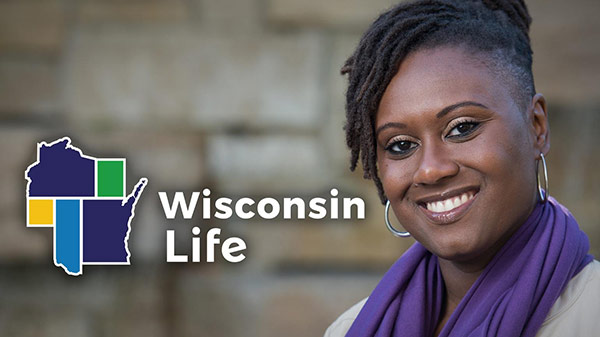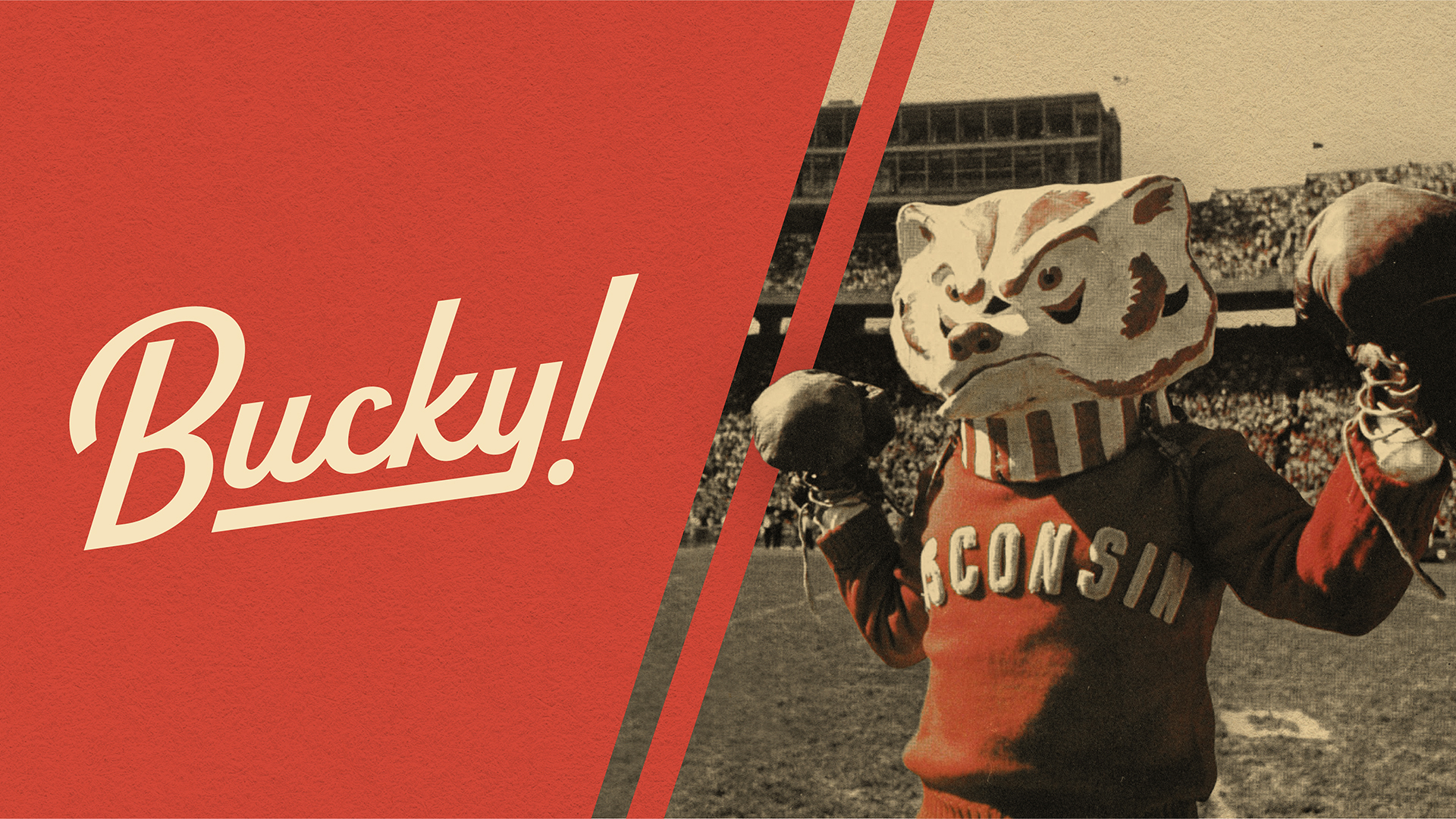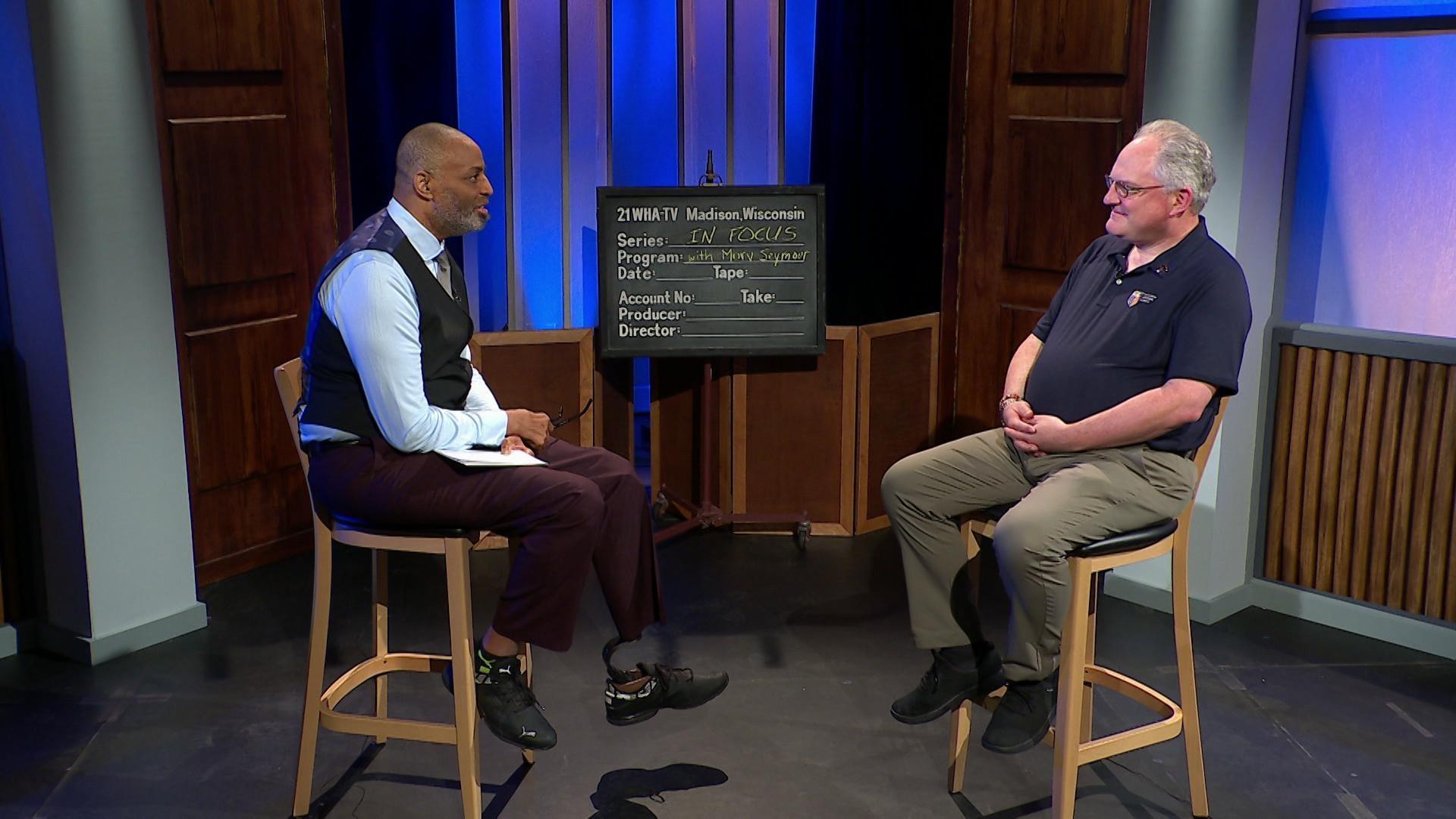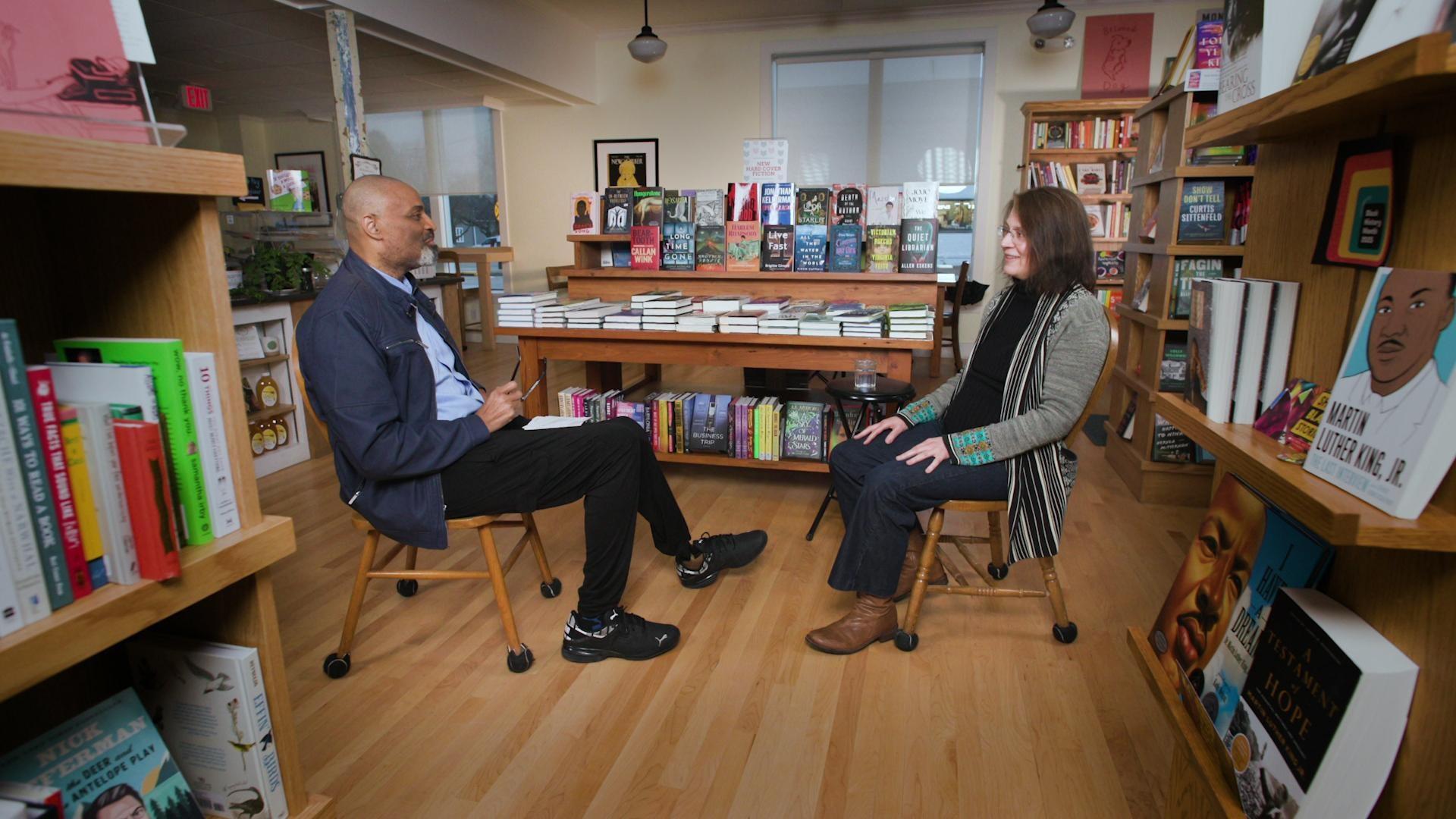In Focus with Stephen Kantrowitz: Keeping history present
Murv Seymour talks with Stephen Kantrowitz at the Wisconsin Historical Society about his writing on Black and Indigenous struggles, the politics of racism and the importance of learning about history.
By Murv Seymour | In Focus
July 29, 2024
VIDEO TRANSCRIPT
Murv Seymour:
Stephen Kantrowitz, welcome to "In Focus."
Stephen Kantrowitz:
Glad to be here.
Murv Seymour:
I'd love to get your perspective on being in this space. We're here at the Wisconsin Historical Society, and this is a place where history is kept.
Stephen Kantrowitz:
Yep.
Murv Seymour:
And the young folks out here come here and spend hours upon hours. Bring back any memories for you?
Stephen Kantrowitz:
Oh, yeah, I've spent a lot of time in this room and in this building. I got to Wisconsin in 1995 as an assistant professor, and I've done a lot of research in this room. I've done a lot of teaching in this building, upstairs in the archive room, outside in the reading room, all around here in the stacks. You know, this has been a, it was a big draw for me to come to Wisconsin, that this library was here. And it's been a big magnet holding me here too.
Murv Seymour:
I was going to say, speaking of stacks, how does this space stack compared to other libraries out there?
Stephen Kantrowitz:
This is one of the best libraries in the world for studying North America. Really, full stop. It's got an incredible collection that's been curated amazingly well over many, many generations. And it's got a wonderful archive, like all archives, unique, eclectic, surprising. And this microfilm collection in particular, this room that we're sitting in right now, is unmatched.
Murv Seymour:
Now, you say microfilm; I think about technology and all the access people have with web technology and AI and those sorts of things. Are people still using microfilm?
Stephen Kantrowitz:
Fewer and fewer, I bet. But the amount of, the percentage of microfilm that's been scanned and that is digitally available is minuscule compared to the holding of newspapers and other periodicals and that sort of thing. So you can scratch the surface with what's online. You can learn a lot, but if you really want to do the deep dive into any particular thing, the chances are you really need to come to a microfilm collection somewhere.
Murv Seymour:
Yeah, I'd love to hear your journey in terms of how history became this thing that you wanted to dedicate your entire life to.
Stephen Kantrowitz:
Yeah, I have to take you back to my childhood. I grew up in Brookline, Massachusetts, which is Boston, but not Boston. If you look at a map, it's a fish that Boston is eating. And so it's surrounded by the city on three sides, but it's not part of the city. It's not even part of the county that the city belongs to. And that's because back in the 1870s, the rich folk, the Anglo-Protestant elite of Boston moved away from the Irish Catholics who were dominating the city because they found them distasteful. And they established the streetcar suburb, the first streetcar suburb, or one of the first. And when Boston came calling to annex it in the 1870s, they said no. And so Boston annexed all these other outlying towns. You know the names of them, Allston, Brighton, Dorchester, Mattapan, but not Brookline. Flash forward 80 years, 90 years to when Jews could move into some, but not all suburbs. And my parents moved from New York to Brookline in the early 1960s. And Brookline became a different kind of upper middle-class place than it had been. No longer Anglo-Protestant, but about 50% Jewish. And in the 1970s when I was a boy, Boston, as you may know, explodes into a controversy over the racial desegregation of the Boston Public Schools. So I'm sitting in the driveway of our house, three miles from Boston. You can hear the announcers at Fenway Park from my childhood home. And Boston is exploding, and I am living in the calmest, most protected world imaginable.
Murv Seymour:
How old are you this time?
Stephen Kantrowitz:
I say eight, nine years old.
Murv Seymour:
Wow.
Stephen Kantrowitz:
Yeah, and the news-- My father is sitting in the driveway listening to the radio. And it's all about two things. It's about Louise Day Hicks and the Boston School Committee and the resistance to the desegregation of the Boston Public Schools. And it's about the fall of South Vietnam in 1974.
Murv Seymour:
Wow.
Stephen Kantrowitz:
And those two things were happening, you know, more than 10,000 miles apart from each other. One of them was happening in my backyard, but they might as well have been equally far away for the direct impact they had on my life. And something about that dissonance has sat with me the rest of my childhood and into my adult years, that I could be so close and yet so far from this tumultuous, violent, explosive history of racism in the United States. And I could not let it go. And I've never been able to let it go. And something about that dissonance and that paradox, if you want, of America's promises and failures and people's attempts to remediate those failures, and the intended and unintended consequences of those efforts, all of that has remained kind of at the center of my consciousness and the center of my work.
Murv Seymour:
And you were sensing that at ten years old?
Stephen Kantrowitz:
No, I'm looking backwards, and like we, like historians do, making a judgment about where the moment was when the bug got planted in my brain.
Murv Seymour:
But it seems like there's some connection to that, right? In terms of how it affected you?
Stephen Kantrowitz:
Definitely, definitely. But you know, if you're eight or nine years old and you're experiencing these things, one of the main things you're experiencing is the adults around you and how they're experiencing it. And what I was noticing was, it was 2:57, I'd been picked up from something, and we were sitting in the driveway and it was time to go in the house, but my father was not going to go in the house 'cause then he might miss the news at the top of the hour. And it was so important to him to know what was happening and to feel some attachment and control over that history that was unfolding in front of us. And I learned that lesson. I learned that from my father and from my mother both, you know, the importance of reading the news and understanding where it came from and understanding that things were actually happening and that they mattered. And it wasn't a game and it wasn't unimaginably far away. It actually did affect you in some way.
Murv Seymour:
I'd love to get your perspective on what makes history, how is history made? What happens that becomes big enough that it becomes "history?" How does that define?
Stephen Kantrowitz:
Hmm, I mean, I think we're constantly rethinking and reimagining that, right? Because obviously in some level, everything that's ever happened is history. But that the map of that is the same size as the map of the world. And so where would you put that, right? You can't do that. So we isolate trends and events and people and event, you know, and try to say, "These are the things that really matter." But it's all provisional. It's all about where we think we are and what matters in the moment that we are in. And then we look back and say, "So, how did we get here?" And we isolate the events and the people and the processes that got us here. But what that is in one generation is not the same as it is in the next, you know? We're constantly rewriting that because where we are seems really different than where we used to be. And so the things that got us here also seem really different. So people sometimes say, "Oh, that's revisionist history." I'm like, "What else?" That's all we got is revisionist history. 'Cause we can only revise, we can only rethink and reimagine what was truly important.
Murv Seymour:
Yeah, and a lot of your research deals with race. I'm going to assume that really connects back to, you know, this childhood that you experienced and the unrest that you kind of visualized. How did you, you kind of touched on it, but how did you end up falling into that genre of history?
Stephen Kantrowitz:
You know, I wanted to tell stories that made sense to the world. And for a long time, I thought I was going to be an English major. 'Cause I thought, "That's where you tell stories." And then I learned that in fact, history was where people kind of rigorously tried to make sense of things in the way that I could make sense of. So that happened in some ways in high school with some great teachers I had, Brad Wright. And then in college, great storytellers, Ed Morgan, John Boswell, David Montgomery, you know, Bill Cronon. People telling really well-crafted, persuasive stories about the past that reorganized the way I thought about the world I was living in. And then I got the chance to do a little research in college. And after a little break, went back and did a PhD. And I have never really looked back. You know, I've had moments where writing a book seems too hard and I don't want to do it anymore, but then I keep doing it. Right. The teaching has never gotten old. Never gotten tired of that. If I ever do get tired of that, then it's time to retire, but that's not happening.
Murv Seymour:
Yeah, and we know race, talking about it, at least in this country, can be very difficult and very kind of combative. Why do you think it's so difficult for folks to talk about race?
Stephen Kantrowitz:
Because... [chuckles]
Murv Seymour:
Not the evil laugh.
Stephen Kantrowitz:
No, well, you know... [Murv chuckling] This is difficult to talk about, but there is a presumption and a myth of innocence among white Americans. Not only white Americans, but in which what people have achieved is because they deserve it. By extension, what people don't achieve is 'cause they don't deserve it. What people have is given to them by the grace of providence, or democracy, or the republic, or something. And anytime you suggest that the structures on which that's built have contained inequities, or let alone great evils, you're challenging the bases on which people have built their sense of themselves and their culture and their nation as fundamentally good. And it's not that I want to tell the opposite story, that they or their culture or their nation are fundamentally bad. There's no, what's the point? And also, nothing is fundamentally good or fundamentally bad, actually, I think. It's what you do with it. And... But the challenge is that people are so committed to sort of a myth of personal and cultural and familial and national innocence that the challenge to that feels personal to them. And so when you say, "The White House was built with slave labor." Or you say, "Every square foot" that we are living on very recently belonged "to somebody else, and the process of transforming it into American land was often a very violent one." Anytime you say those things, you rip a hole in that sort of veil of innocence, and people don't like to do that. So finding ways to persuade them that not to do that is dishonest. That's the challenge here, I think.
Murv Seymour:
Yeah, and a lot of your work on race centers around the 19th century. What is it about that time period that really attracted you?
Stephen Kantrowitz:
Just lucky, I guess. I don't know why exactly the 19th century grabbed me the way it did. It's just an accident really of the particular teachers I encountered at a particular moment. But I was very lucky to begin graduate school at Princeton the same year that a newly hired professor arrived there, a woman named Nell Irvin Painter. And she's a very creative, brilliant, idiosyncratic historian, mostly of African American and women's experience. And she just kind of lit a fire under me in a variety of ways. And there were other people, of course, in my graduate program who were important that way. And the other historians I was working with, my peers in the program who I thought were so brilliant, were also 19th century historians. And that just seemed like the place where it was happening, the place where you could really do some fantastic work. As it turns out, most of my, you know, friends and colleagues here over time have been civil rights historians, you know, people working in the 20th century. So we go back and forth and they say, you know, "It was, 19th century, it's an important prologue." "You know, it's 20th century is sort of, you know, the coda to the story here." But you know, we tease each other, but it's not that I think the 19th century is uniquely important. It's just, I find it fascinating for reasons I can't really articulate.
Murv Seymour:
Yeah, you've written about white supremacy in politics. I'd love to hear what the takeaway was there in terms of, you know, the importance and the correlation?
Stephen Kantrowitz:
So, if I could distill it down to one sentence, it would be, white supremacy is hard work. White supremacy is not what's bred in the bone. It's not a sort of natural feature of some white racial imperative. White supremacy is a political project, and people worked and work really hard to make it work and to make it function and to make it plausible and to make it persuasive. And that's a really important lesson because it's important to say, "Whiteness is not, to be white is not necessarily to be white supremacist." And what white supremacy wants you to believe is that whiteness is biological, inherent, essential, conquering, and violent. And once you accept any part of those premises, you can be drawn pretty far down a kind of a white supremacist path. So I think it's really important to understand white supremacy not as inborn, not as biological, not as kind of essential or pre-rational, but as a political project that individuals and organizations do in order to create certain kinds of change in the world. Not the kind of change I'd like to see, but I think it's important to understand it that way.
Murv Seymour:
And when you say white supremacy is work, you mean like in terms of the overall effort that it takes to hate, I guess?
Stephen Kantrowitz:
To organize people to hate, to organize the structures of society in ways that ratify white supremacy's premises, which is that white people are superior to other kinds of people. And that... Those are projects, right? Those require organized, you know, or the organizing work of institutions, and propaganda, and, you know, the first book I wrote was called "Ben Tillman & the Reconstruction of White Supremacy." And it's about the son of a slaveholding family who comes of age at 18 in 1865, when the world he's been raised to rule no longer exists. And he spends the rest of his life trying to recreate the world of his childhood in a world that doesn't have slavery in it anymore. And that requires reorganizing white Southerners, South Carolinians in this context, to rethink their relationship to racial supremacy in a world where slavery won't bolster it. And they need to create other forms and other forces to do that work that slavery used to do. And so they use terrorism, they use law, they use constitution making, they use mob action. They use all kinds of different things to try to reconstruct that world. But the lesson of it is they're very successful, but they have to keep at it. They can't ease up because the challenges to it from Black people, of course, but also from white people who understand that this is not actually serving them very well, are constant and ongoing. And so white supremacy is a constant act of pushing back against those more egalitarian and insurgent forces in the society.
Murv Seymour:
Yeah, and one of the things that really surprised me during my research for my project, "Wisconsin in Black & White" that looked at systemic racism in the state of Wisconsin, I stumbled across photos of these massive Klan rallies here in Madison, rebel flags being flown and carried on the University of Wisconsin campus. And not only was I surprised, but a lot of people were surprised that there was this connection with the Ku Klux Klan here on this campus.
Stephen Kantrowitz:
I mean, exactly a century ago is when those rallies and marches, you know, down King Street.
Murv Seymour:
1920s?
Stephen Kantrowitz:
Yeah, 1920s, yeah. Yeah, exactly 100 years ago, the height of the Klan as a national force and its effort to build a white supremacist infrastructure all over the country. I mean, Indiana was the biggest Klan state, but the people were trying hard to make Wisconsin into a Klan state too.
Murv Seymour:
So did it work?
Stephen Kantrowitz:
It worked somewhat. Wisconsin's a hard-- It was a harder place than some to do it because for one thing, the Klan was intensely anti-Catholic in the 1920s. And there are a lot of Catholics in Wisconsin. So that was—
Murv Seymour:
And people forget too, the Klan didn't, they don't just dislike African Americans. It's all immigrants and...
Stephen Kantrowitz:
Yeah, yeah, yeah. It was a very specific vision of who the real white people were. And they were Northern European Protestants. Those were the real white people.
Murv Seymour:
Yeah, I saw they targeted the Greenbush community here. Is it Greenbush?
Stephen Kantrowitz:
Yep, yep, yep. And targeting a neighborhood that was Italian and Jewish and African American.
Murv Seymour:
And I also thought it was interesting that there, you did a paper for the then-chancellor on the evolution of the Klan here. And from what I read, they infiltrated some of the fraternities and tried to make it a social.
Stephen Kantrowitz:
So there were two Klans on campus here at UW-Madison. There was one that was literally started by the national Ku Klux Klan. And it started a fraternity for young Klansmen called Kappa Beta Lambda, which stood for Klan's KBL, Klansmen Be Loyal. And they had a fraternity house on campus for a couple years. And then there was another group called Ku Klux Klan that was a social club, seems to have been started as an affiliate of a similar club at the University of Illinois. And it was kind of the big men on campus of that era. And the argument has been made that that second group really shouldn't be tarred with the brush of the Ku Klux Klan. And to which I would simply say, "No young white person," no young person in the United States virtually in 1921, was ignorant about what Ku Klux Klan meant." "Birth of a Nation," which in some ways led to the resurgence of the Ku Klux Klan, had come out in 1915 and was still the most popular movie in the country in 1920. Every young person had grown up with the imagery of the Klan pushing back against the racially egalitarian project of Reconstruction in the grossest white supremacist terms. So whether they were just, thought they were just horsing around or were intensely committed to a white supremacist project, they had to know what they were doing on some level.
Murv Seymour:
I wanted to share with you that I had, in my journey as a newscaster, I got a chance to cover a lot of different things. And I had the experience of covering about five different Klan rallies in my career. And the first one I did was in Louisiana. So I wanted to show you this picture.
Stephen Kantrowitz:
Oh, wow. That's a terrific picture.
Murv Seymour:
Yeah, that's me on the right there.
Stephen Kantrowitz:
Yeah.
Murv Seymour:
And what you don't see is there's 17 other Klansmen standing next with this guy.
Stephen Kantrowitz:
Yeah.
Murv Seymour:
And they were having a protest in Bogalusa, Louisiana, you know, and--
Stephen Kantrowitz:
When was this?
Murv Seymour:
This was 1989.
Stephen Kantrowitz:
Okay.
Murv Seymour:
1989, 1990.
Stephen Kantrowitz:
Okay, so David Duke's Klan, yeah.
Murv Seymour:
David, yeah, he was, and I'm not sure if this was, I don't know if he was involved with this one 'cause his name was not quite on the scene yet. 'Cause he, you know, he's out of Louisiana. I think he's out of, he was out of Hammond, right, Hammond?
Stephen Kantrowitz:
He's out of Metairie, I think.
Murv Seymour:
Is it Metairie?
Stephen Kantrowitz:
Thought so.
Murv Seymour:
I covered him when he ran for governor of Louisiana as well.
Stephen Kantrowitz:
Okay, you know that story.
Murv Seymour:
But this guy was out of, he was out of, I think, out of Lakeland or Polk County, Florida.
Stephen Kantrowitz:
Okay.
Murv Seymour:
Yeah, and somebody snapped that picture and it was just one of those interesting things.
Stephen Kantrowitz:
That's a great picture.
Murv Seymour:
And it's a slice of history, and I always like to share it every now and then because it's one of those things, it's a picture you tend to see in history books, you know, and that's in my lifetime.
Stephen Kantrowitz:
That's in your lifetime.
Murv Seymour:
Yeah.
Stephen Kantrowitz:
My daughter, who's 15, has a critique of the way these pictures are represented to us, which is that so many of them are in black and white that it makes you think it was a long time ago. And that if more of our pictures of even of the Civil Rights Movement, but then also of later moments were in color, it might be easier for young people to understand just that this isn't unimaginably far away in time. That this is part of our own world.
Murv Seymour:
Yeah, I find it interesting, like when you live long enough, and I hate to sound like the old guy, but you find that you are living history. And in a lot of ways, I feel like my life has been part of history, especially when I see pictures like that. And it's just one of those interesting things that you don't think about until you reflect back—
Stephen Kantrowitz:
No, right.
Murv Seymour:
On something, 'cause that was, you know, what, 35 years ago or so, something like that. So yeah, I wanted to share that with you.
Stephen Kantrowitz:
Yeah, nice.
Murv Seymour:
I wanted to touch a little bit on your latest book, "Citizens of a Stolen Land." I think about the title. It seems like it says something there. Is that purposeful?
Stephen Kantrowitz:
Yeah, yeah, it's, the title points to the kind of paradoxical situation of the Ho-Chunk people, who lost their homeland of Wisconsin through a series of fraudulent treaties in the 1820s and 1830s, who were legally expelled from Wisconsin shortly thereafter. And for all legal purposes, were outlaws in Wisconsin thereafter. And yet who either remained, refusing to leave and be expelled, or returned to Wisconsin and reestablished themselves as a literal presence in Wisconsin. But then in the 1860s and '70s, managed to reestablish themselves as a legal presence in Wisconsin. And then in the 20th century, to get re-recognized by the federal government as a Native nation, as a sovereign nation. And so, what the Ho-Chunk people achieved through creativity and resistance and struggle during the 19th century was to reestablish themselves as citizens of the United States on their own stolen land.
Murv Seymour:
Wow.
Stephen Kantrowitz:
And that is a remarkable achievement. Also only a partial victory, of course, because many forms of colonialism continued and continue to work their way upon the Ho-Chunk and other Native people, of course. But there's both a paradox and a kind of victorious quality to that title, I think.
Murv Seymour:
Yeah, and paint a picture for me in terms of, are they mainly here in Wisconsin these days, or where are they?
Stephen Kantrowitz:
So, because of the nature of the 19th century exile and diaspora that they undergo, the Ho-Chunk end up in two distinct contemporary nations. And one of them is the Ho-Chunk Nation of Wisconsin. The other is the Winnebago tribe in Nebraska. Same culture, same language, many family relationships, many close connections. But for the purposes of federal recognition and the purposes of national sovereignty, two separate nations.
Murv Seymour:
And what drew you to this project?
Stephen Kantrowitz:
I live here; this is their homeland. And I'd been living here for quite a while before I had really given that much thought. And once I started to give that some thought, I realized, "How is it that I have come through so many decades "as an American historian without giving Native history more than a passing thought?" And once I got that, once I started to really think that through and realized what the shortcomings in my training, the shortcomings in my own approach to the history had been, and how new that fact was to most of my friends and neighbors, then I just couldn't resist. And I had to dig in and do this work.
Murv Seymour:
Yeah, one of the first things I saw when I opened the book is you have a disclaimer in your opening introduction. I thought that was very interesting. You kind of let everyone know that, "Hey, I may not get this right." Not something you see when someone writes a book. Why did you feel a need to do that?
Stephen Kantrowitz:
Well, I'm not a Ho-Chunk person. I'm not deeply steeped in Ho-Chunk culture. I know a few words of the Ho-Chunk language. There are so many things that are essential to being Ho-Chunk and to understanding the historical dimensions of the Ho-Chunk experience that I will never really understand. And so, I felt compelled to acknowledge that at the get-go. A Ho-Chunk historian would write a very different book than the one I've written. And I hope very soon, one will. I'd love to see that book. And the success of this book, of my book would be for that historian to say, "What Kantrowitz failed to understand was..." Then I would feel like, "Okay, I did, the book did what it needed to do." But the other mission of the book is for non Ho-Chunk people, for non-Native people to take that moment, that long moment to sit and marinate on the fact, as I said a few minutes ago, that every square foot that we stand on, almost every single one was, not very long ago, somebody else's. And that those people are mostly still here, and they are living in the aftermath of an apocalyptic event and continuing to live lives and continuing to maintain their cultural integrity and their languages and their ways of being with one another and with other people. And that's invisible to so many non-Native people. And yet it's a fact of millions of people's lives. And it's a fundamental fact of our national history. And it just, it kind of shocks me that it took me so late in my life to come to an awareness of that, even though I'm an American historian.
Murv Seymour:
Yeah, I'm wondering, emotionally, does it do anything to you, writing about African-American culture and Ho-Chunk culture and those sorts of things?
Stephen Kantrowitz:
There's always a risk that I will be perceived as, or worse, be in a kind of a missionary position. Like, "Let me tell you about these poor people and their plight," right? And that is the last thing that I want to do. And anytime I start to smell that in the air, I have to turn around and go in a different direction because that is not my purpose. My purpose is to uncover and explore histories of the way people have continued to live and insisted on their right to live dignified lives on their own terms in a nation that has not always made that possible and has rarely made that easy.
Murv Seymour:
Yeah, I'd love to get your perspective in terms of what you think the state of things are in terms of teaching history today?
Stephen Kantrowitz:
Yeah, teaching history, history teachers are in a lot of trouble. There are a lot of laws and political movements that are designed to restrict what teachers can say in the classroom and restrict what students can hear in the classroom and allow students to opt out of hearing histories that their parents think they might not want to hear. And so there's a kind of, "If I can't hear it, it didn't happen." And that's the antithesis of what history is for. And so, we have to find ways to fight back against these laws and against these political movements, or we're not going to have a history that means anything. It's simply going to be a feel-good story. And a feel-good story is just propaganda. That's not too hard a word for it. The other threat to history is the dramatic emphasis on what we call the STEM fields, which are super important and super interesting. And I don't begrudge any student or any teacher their passion for those things. But we've created the society that undervalues the humanities, that undervalues the written word, that undervalues the kind of deep, considered storytelling that the humanities can offer. And students are getting the message. And so enrollments in history classes are shrinking and shrinking, not because historians and history teachers are not doing a good job, but because the society has devalued those things. So from both of those angles, I would say history's in trouble, not because of the quality of the work we're doing, but because of the social decisions and the political movements around us.
Murv Seymour:
I love asking people about their profession in terms of what keeps them up at night. What keeps the history professor up at night?
Stephen Kantrowitz:
With worry, do you mean?
Precisely what I've been talking about there. That's what keeps me up at night is the moment when the other shoe drops in Wisconsin, you know? If I were in Texas or Florida or someplace else, it had already dropped.
Murv Seymour:
Can we change history by restating it and reframing it, depending on who's giving the narrative?
Stephen Kantrowitz:
I mean, in some ways, we have to trust that we can. But what we're really doing, I'm not naive. I don't think that of the 75 students in my classroom, I'm going to make 75 historians. I might make one, and that might be what the market will bear, but what I'm hoping is, 50 or 60 of them leave the class with a historical mindset and an unwillingness to be snowed by the kind of propaganda and the kind of easy answers that people want to feed them in providing answers for what to do about the state of the world. I think if you have a historian's mindset, you're less likely to fall victim to those kinds of easy answers. Less likely to fall victim to that kind of propaganda. More likely to ask some harder questions and want to get to some more complex answers.
Murv Seymour:
Last question here. How is history going to define this period that we're living in now, say 100 years from now?
Stephen Kantrowitz:
I mean, we can never, you and I are not going to know the answer to that, right?
Murv Seymour:
But I wish I could be here.
Stephen Kantrowitz:
I kind of do too. But someone's going to write that history and someone's going to look back at this moment, and this is a really fraught and complicated moment. And I think on the table are things like the future of democratic self-government. And so I think we, what I hope is that we will look back, people, historians will look back on this period 100 years from now and write about a moment of ferment that produced a renewed commitment to democratic self-government here and around the world. What I fear is that it will be the history of the failure of democracy and its replacement by a system that I don't think either of us would appreciate living under.
Murv Seymour:
Dr. Stephen Kantrowitz, thank you for being here on "In Focus."
Stephen Kantrowitz:
It's been a real pleasure. Thanks for having me.
 Passport
Passport











Follow Us